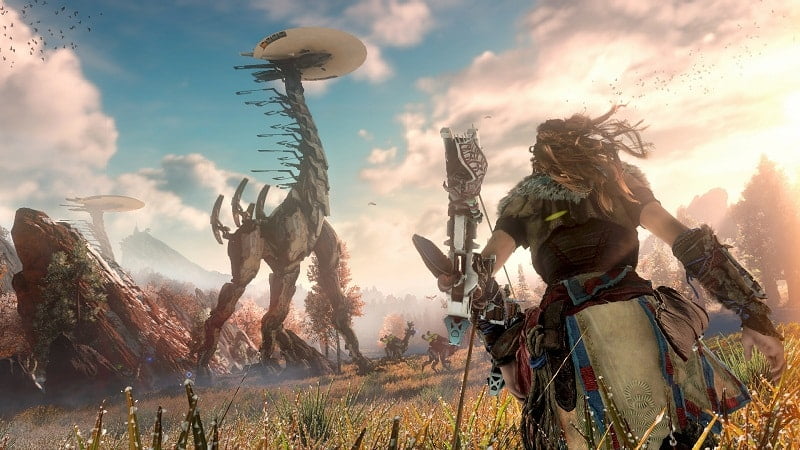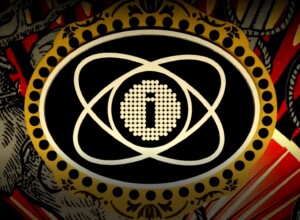I didn’t see this one coming – which, depending on how you look at it, might be mad.
On the one hand, its headlights have been glaring for some time: big-budget AAA, Guerrilla games, Sony exclusive, new IP. There were lots of reasons to see this one coming – there were robot dinosaurs in the trailers for Christ’s sake.
But then, at the same time, there were all sorts of reasons not to: it looked like a post-Assassin’s Creed, post-Witcher, polished product of an open-world – the result of iteration and refinement that would be fantastic in the way that any Assassin’s Creed game would be, if you hadn’t just played one.
In Horizon Zero Dawn lives the kind of design that renews faith. It bears the stigmata of open-worlds gone by: the towers, quest lists, crafting, and skill-trees that drag your eyelids downward if you give them long enough. But it sings with an element of cure. It slaps the wrung-out towel of sandbox design back into a sink of cool water and drapes it across your forehead like a salve.
It feels so good to have that atropine-eyed sensation of ‘fuck me it’s four and I haven’t eaten.’ What’s so much sweeter than this being brand new, is it demonstrating that old design works, and will always work, if its executes to perfection.
What’s happened in open-world games like Far Cry and Assassin’s Creed is this trickling tendency toward the symptoms of success. Each feature is tinkered with and buffed to a mirror-sheen before being folded carefully into a formula that relies on the result being the sum of its parts.

What Horizon Zero Dawn has is an ecstatic yoke enhanced with detail and distraction – not built on them. The real strength of any game is in what you can strip away and still have it captivate.
At Horizon’s heart are those magnificent creatures. The legendary special effects master Ray Harryhausen once said of creature design: “A lion can be absolutely malignant or benign, majestic, depending on what it’s doing. If your creature cannot be in repose, then it’s a bad design.” Standing sculpturally still beside streams, grazing in open plains, majestic and mettlesome, and quick to anger: they are real and they’re to be respected, feared, and hunted.
And no two encounters are the same. There are endless permutations – higher and lower ground, obstacles, water, numbers, enemy-types – and an array of weapons to add rich strategy and chaotic payoff. Not since Ratchet & Clank has there been a selection of such bizarre and brilliant weapons; they entreat creativity, passivity and cunning, and reward you with dopamine-spike explosions, bursts of flame and crackling sparks. It’s impossible not to be, yourself, felled.
What of the sandbox itself? it achieves what Assassin’s Creed always tries for: that feeling of awe-struck excavation. Rather than painstakingly creating an ancient civilisation, Guerrilla paves over one: ours. There’s nothing quite like the first time you encounter the remnants of the Old Ones, as they’re called: the odd sense of dumbfounded wonder as the cacophony of our culture – phones, taxis, companies, night clubs – is brought into jarring alignment with this brave new world.
Part of why it’s so odd is that you’re enraptured with its opening hours, catapulted into its tribal politics, its teeming cultures and warm characters, that the idea that you are in fact in what was Colorado is like a cosmic slap. The word ‘Colorado’ seems unreal. Aloy’s curiosity about the old ones is our own – we want to know how we fucked things up.

There was a moment where I stood at the ruins of an ancient city. The reticulated spines of its skyscrapers were backlit by an insanely blue sky, and all of a sudden, it occurred to me that this was the remains of the open-world I might well have been exploring a few Watchdogs games down the line. The sort of blank, steel-and-glass metropolis filled with gadgets and game mechanics written in camel case. It felt as though it wasn’t in the face of some cataclysm that this place fell into obsolescence. It was that it was always like this: a scrapyard vista of recycled ideas.
It’s also rare that technical fidelity is employed in such lockstep with art direction. From milky moonlight through the shins of pine forests, to the peach glaze of a sunrise, there’s beauty in every frame. Seeing rain for the first time made me stop and pan the camera; when I did, Aloy held her palms to the sky and ran them over her face. I think in that moment I felt exactly as she did: spiritually surfeited.
It’s a stunning achievement, and one I look forward to carrying on with in 2018.






